Abstract
1. The effects of a coelenterate toxin, palytoxin (PTX) have been studied in the isolated detrusor muscle. of the rat. 2. PTX (1-100 nM) initiated concentration-dependent contractions of the detrusor; the contraction led to an irreversible tachyphylaxis. Muscle desensitized to PTX continued to respond to acetylcholine (ACh) and excess K+ but the contractions were reduced compared to pre-PTX contractions. 3. Contractions evoked by PTX were not affected by the presence of atropine (10 microM), indomethacin (10 microM) or tetrodotoxin (0.5 microM) but were greatly reduced by nifedipine (3 microM) and by the absence of K+. PTX could not evoke contractions in the absence of Ca2+ or in tissues depolarized by exposure to excess K+. 4. PTX abolished the neurogenic contractile responses to electrical field stimulation (EFS). 5. Combined treatment with atropine (10 microM) plus nifedipine (3 microM) abolished contractile responses to EFS and greatly reduced the contractile response to PTX. 6. The contractile response to PTX (100 nM) was reduced following exposure of the muscle to alpha, beta-methylene ATP. 7. Exposure to PTX (100 nM) for 1-3 h reduced both the ACh content of the detrusor (by more than 80%), and the immunoreactivity of neuropeptide Y-containing nerve fibres compared to control. 8. It is concluded that the primary effect of PTX is to promote the release of endogenous motor transmitters, leading to their eventual depletion.
Full text
PDF
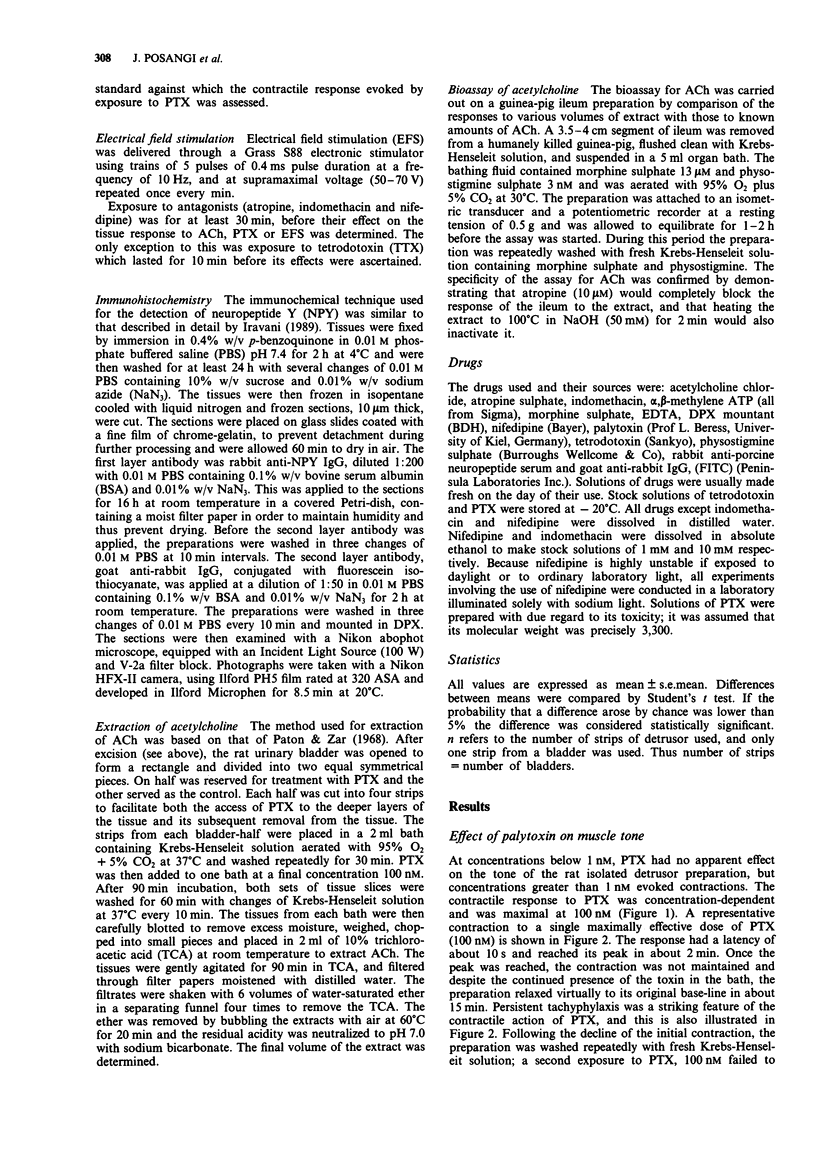

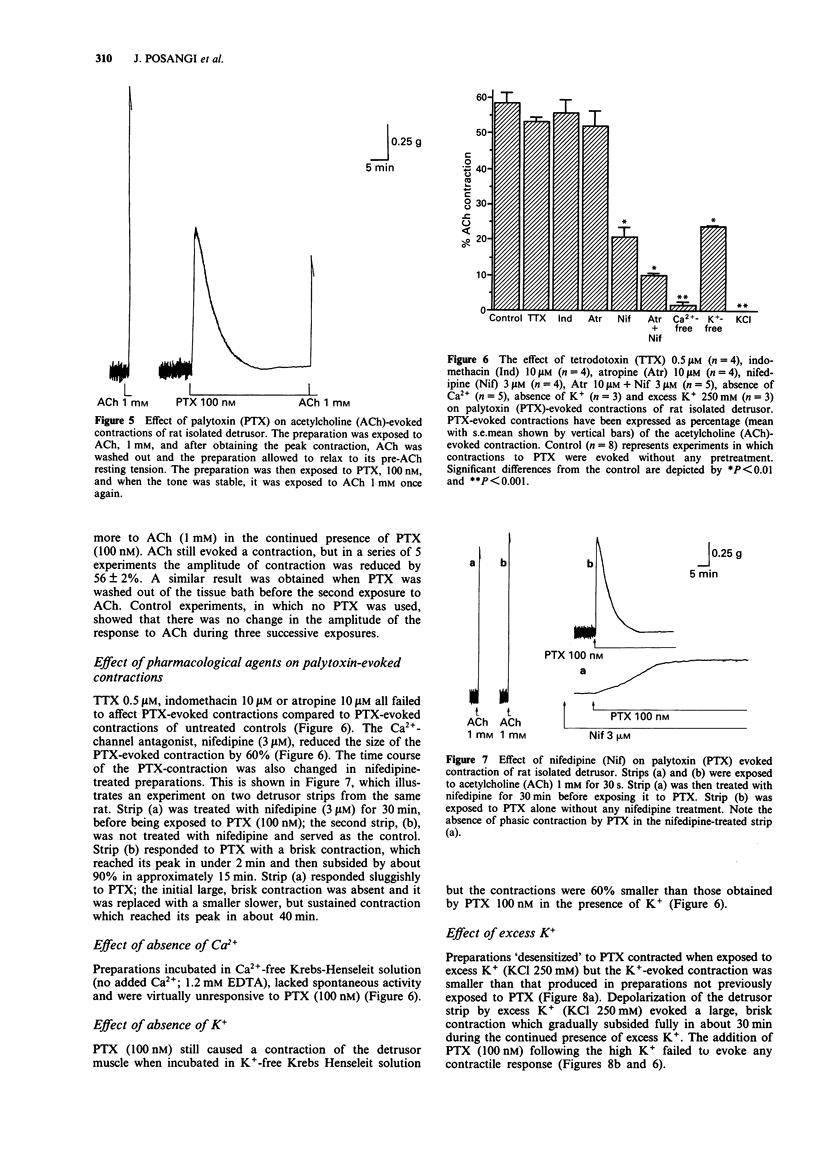
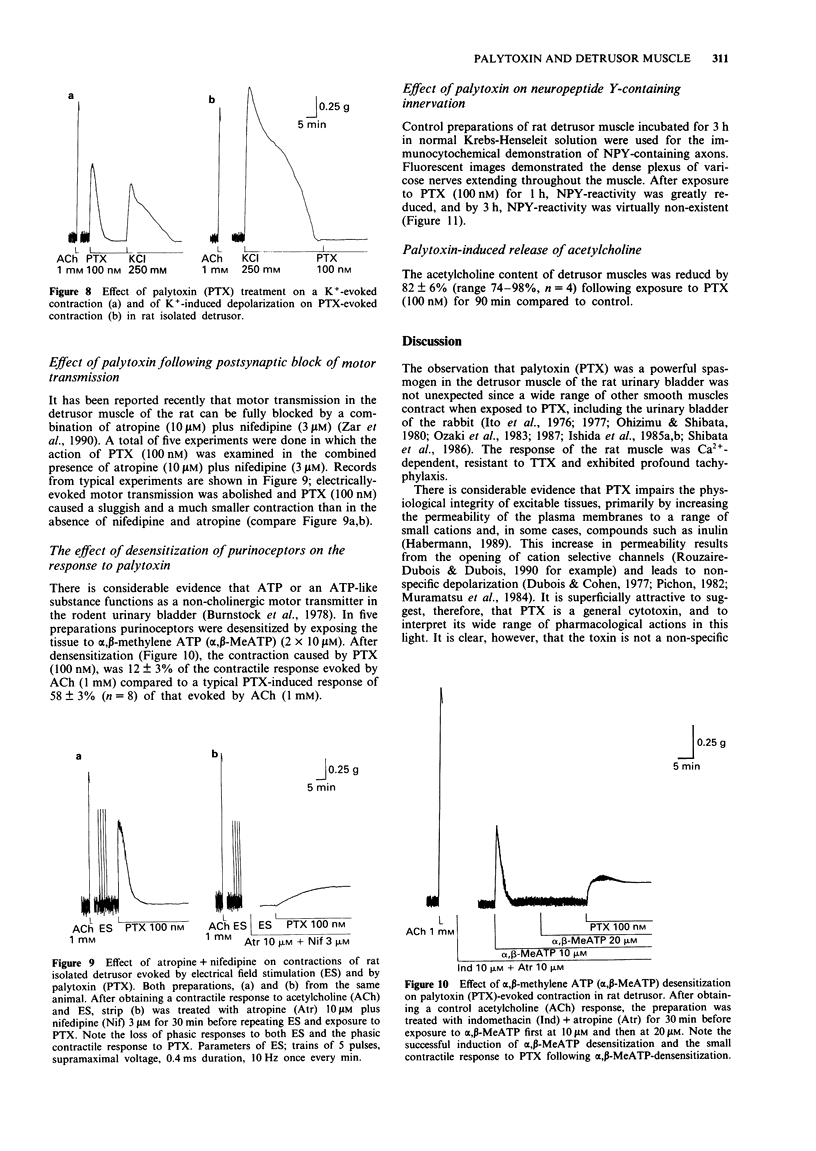

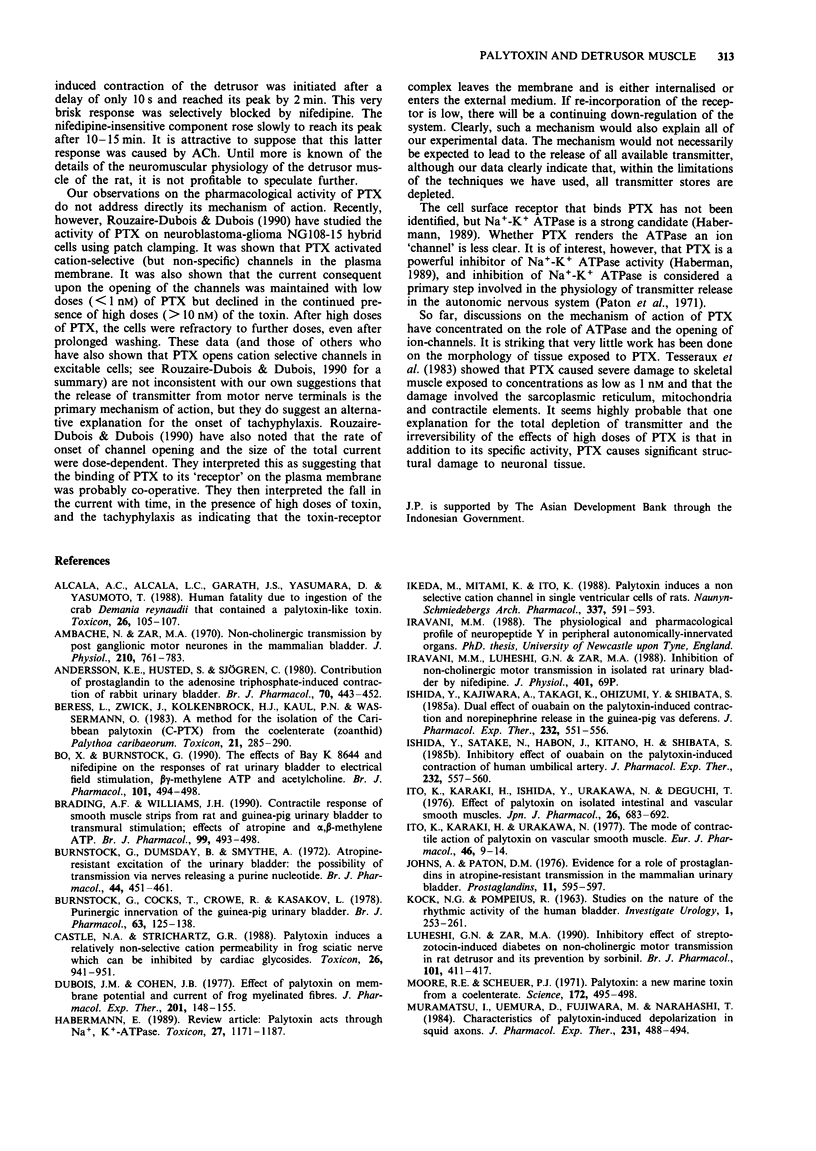
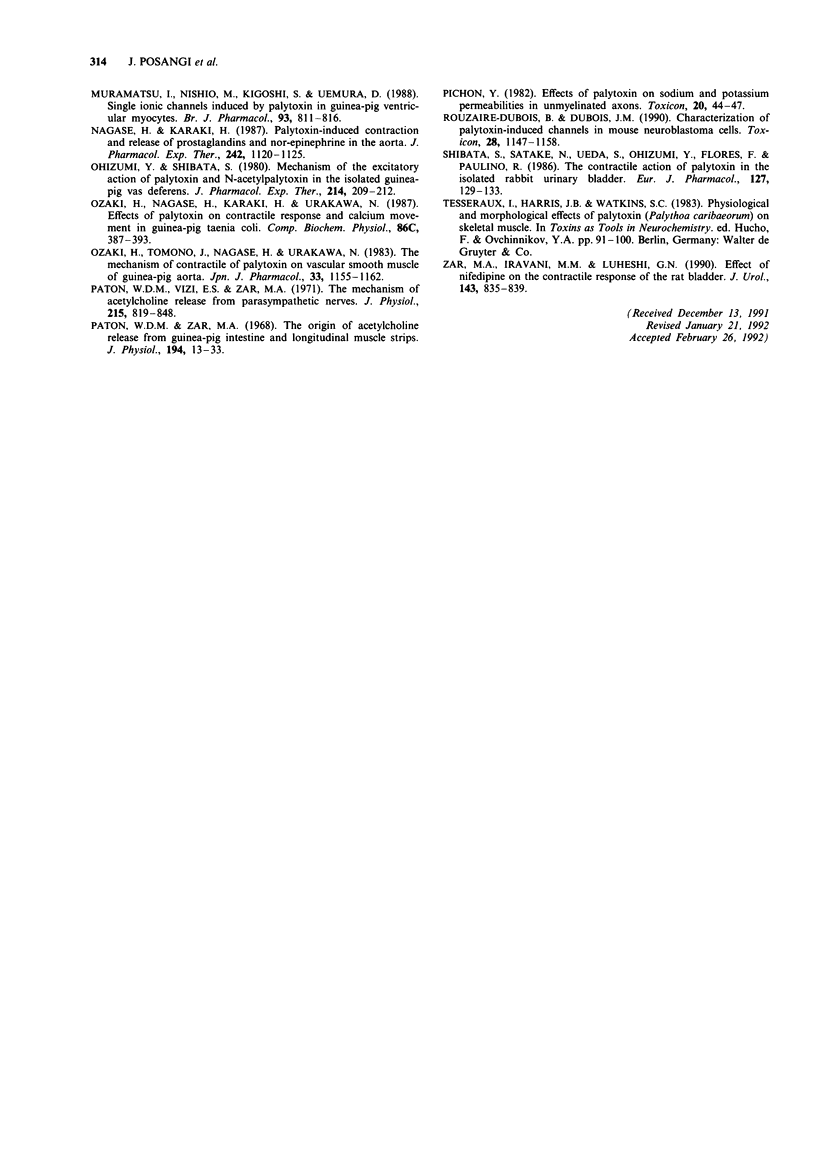
Images in this article
Selected References
These references are in PubMed. This may not be the complete list of references from this article.
- Alcala A. C., Alcala L. C., Garth J. S., Yasumura D., Yasumoto T. Human fatality due to ingestion of the crab Demania reynaudii that contained a palytoxin-like toxin. Toxicon. 1988;26(1):105–107. doi: 10.1016/0041-0101(88)90142-0. [DOI] [PubMed] [Google Scholar]
- Ambache N., Zar M. A. Non-cholinergic transmission by post-ganglionic motor neurones in the mammalian bladder. J Physiol. 1970 Oct;210(3):761–783. doi: 10.1113/jphysiol.1970.sp009240. [DOI] [PMC free article] [PubMed] [Google Scholar]
- Andersson K. E., Husted S., Sjögren C. Contribution of prostaglandins to the adenosine triphosphate-induced contraction of rabbit urinary bladder. Br J Pharmacol. 1980 Nov;70(3):443–452. doi: 10.1111/j.1476-5381.1980.tb08722.x. [DOI] [PMC free article] [PubMed] [Google Scholar]
- Bo X. N., Burnstock G. The effects of Bay K 8644 and nifedipine on the responses of rat urinary bladder to electrical field stimulation, beta,gamma-methylene ATP and acetylcholine. Br J Pharmacol. 1990 Oct;101(2):494–498. doi: 10.1111/j.1476-5381.1990.tb12736.x. [DOI] [PMC free article] [PubMed] [Google Scholar]
- Brading A. F., Williams J. H. Contractile responses of smooth muscle strips from rat and guinea-pig urinary bladder to transmural stimulation: effects of atropine and alpha,beta-methylene ATP. Br J Pharmacol. 1990 Mar;99(3):493–498. doi: 10.1111/j.1476-5381.1990.tb12956.x. [DOI] [PMC free article] [PubMed] [Google Scholar]
- Burnstock G., Cocks T., Crowe R., Kasakov L. Purinergic innervation of the guinea-pig urinary bladder. Br J Pharmacol. 1978 May;63(1):125–138. doi: 10.1111/j.1476-5381.1978.tb07782.x. [DOI] [PMC free article] [PubMed] [Google Scholar]
- Burnstock G., Dumsday B., Smythe A. Atropine resistant excitation of the urinary bladder: the possibility of transmission via nerves releasing a purine nucleotide. Br J Pharmacol. 1972 Mar;44(3):451–461. doi: 10.1111/j.1476-5381.1972.tb07283.x. [DOI] [PMC free article] [PubMed] [Google Scholar]
- Béress L., Zwick J., Kolkenbrock H. J., Kaul P. N., Wassermann O. A method for the isolation of the caribbean palytoxin (C-PTX) from the coelenterate (zooanthid) Palythoa caribaeorum. Toxicon. 1983;21(2):285–290. doi: 10.1016/0041-0101(83)90013-2. [DOI] [PubMed] [Google Scholar]
- Castle N. A., Strichartz G. R. Palytoxin induces a relatively non-selective cation permeability in frog sciatic nerve which can be inhibited by cardiac glycosides. Toxicon. 1988;26(10):941–951. doi: 10.1016/0041-0101(88)90259-0. [DOI] [PubMed] [Google Scholar]
- Dubois J. M., Cohen J. B. Effect of palytoxin on membrane and potential and current of frog myelinated fibers. J Pharmacol Exp Ther. 1977 Apr;201(1):148–145. [PubMed] [Google Scholar]
- Habermann E. Palytoxin acts through Na+,K+-ATPase. Toxicon. 1989;27(11):1171–1187. doi: 10.1016/0041-0101(89)90026-3. [DOI] [PubMed] [Google Scholar]
- Ikeda M., Mitani K., Ito K. Palytoxin induces a nonselective cation channel in single ventricular cells of rat. Naunyn Schmiedebergs Arch Pharmacol. 1988 May;337(5):591–593. doi: 10.1007/BF00182738. [DOI] [PubMed] [Google Scholar]
- Ishida Y., Kajiwara A., Takagi K., Ohizumi Y., Shibata S. Dual effect of ouabain on the palytoxin-induced contraction and norepinephrine release in the guinea-pig vas deferens. J Pharmacol Exp Ther. 1985 Feb;232(2):551–556. [PubMed] [Google Scholar]
- Ishida Y., Satake N., Habon J., Kitano H., Shibata S. Inhibitory effect of ouabain on the palytoxin-induced contraction of human umbilical artery. J Pharmacol Exp Ther. 1985 Feb;232(2):557–560. [PubMed] [Google Scholar]
- Ito K., Karaki H., Ishida Y., Urakawa N., Deguchi T. Effects of palytoxin on isolated intestinal and vascular smooth muscles. Jpn J Pharmacol. 1976 Dec;26(6):683–692. doi: 10.1254/jjp.26.683. [DOI] [PubMed] [Google Scholar]
- Ito K., Karaki H., Urakawa N. The mode of contractile action of palytoxin on vascular smooth muscle. Eur J Pharmacol. 1977 Nov 1;46(1):9–14. doi: 10.1016/0014-2999(77)90137-6. [DOI] [PubMed] [Google Scholar]
- Johns A., Paton D. M. Evidence for a role of prostaglandins in atropine-resistant transmission in the mammalian urinary bladder. Prostaglandins. 1976 Mar;11(3):595–597. doi: 10.1016/0090-6980(76)90109-x. [DOI] [PubMed] [Google Scholar]
- KOCK N. G., POMPEIUS R. STUDIES ON THE NATURE OF THE RHYTHMIC ACTIVITY OF THE HUMAN BLADDER. Invest Urol. 1963 Nov;1:253–261. [PubMed] [Google Scholar]
- Luheshi G. N., Zar M. A. Inhibitory effect of streptozotocin-induced diabetes on non-cholinergic motor transmission in rat detrusor and its prevention by sorbinil. Br J Pharmacol. 1990 Oct;101(2):411–417. doi: 10.1111/j.1476-5381.1990.tb12723.x. [DOI] [PMC free article] [PubMed] [Google Scholar]
- Moore R. E., Scheuer P. J. Palytoxin: a new marine toxin from a coelenterate. Science. 1971 Apr 30;172(3982):495–498. doi: 10.1126/science.172.3982.495. [DOI] [PubMed] [Google Scholar]
- Muramatsu I., Nishio M., Kigoshi S., Uemura D. Single ionic channels induced by palytoxin in guinea-pig ventricular myocytes. Br J Pharmacol. 1988 Apr;93(4):811–816. doi: 10.1111/j.1476-5381.1988.tb11466.x. [DOI] [PMC free article] [PubMed] [Google Scholar]
- Muramatsu I., Uemura D., Fujiwara M., Narahashi T. Characteristics of palytoxin-induced depolarization in squid axons. J Pharmacol Exp Ther. 1984 Dec;231(3):488–494. [PubMed] [Google Scholar]
- Nagase H., Karaki H. Palytoxin-induced contraction and release of prostaglandins and norepinephrine in the aorta. J Pharmacol Exp Ther. 1987 Sep;242(3):1120–1125. [PubMed] [Google Scholar]
- Ohizumi Y., Shibata S. Mechanism of the excitatory action of palytoxin and N-acetylpalytoxin in the isolated guinea-pig vas deferens. J Pharmacol Exp Ther. 1980 Jul;214(1):209–212. [PubMed] [Google Scholar]
- Ozaki H., Nagase H., Karaki H., Urakawa N. Effects of palytoxin on contractile response and calcium movement in guinea-pig taenia coli. Comp Biochem Physiol C. 1987;86(2):387–393. doi: 10.1016/0742-8413(87)90101-0. [DOI] [PubMed] [Google Scholar]
- Ozaki H., Tomono J., Nagase H., Urakawa N. The mechanism of contractile action of palytoxin on vascular smooth muscle of guinea-pig aorta. Jpn J Pharmacol. 1983 Dec;33(6):1155–1162. doi: 10.1254/jjp.33.1155. [DOI] [PubMed] [Google Scholar]
- Paton W. D., Vizi E. S., Zar M. A. The mechanism of acetylcholine release from parasympathetic nerves. J Physiol. 1971 Jul;215(3):819–848. doi: 10.1113/jphysiol.1971.sp009500. [DOI] [PMC free article] [PubMed] [Google Scholar]
- Paton W. D., Zar M. A. The origin of acetylcholine released from guinea-pig intestine and longitudinal muscle strips. J Physiol. 1968 Jan;194(1):13–33. doi: 10.1113/jphysiol.1968.sp008392. [DOI] [PMC free article] [PubMed] [Google Scholar]
- Pichon Y. Effects of palytoxin on sodium and potassium permeabilities in unmyelinated axons. Toxicon. 1982;20(1):41–47. doi: 10.1016/0041-0101(82)90141-6. [DOI] [PubMed] [Google Scholar]
- Rouzaire-Dubois B., Dubois J. M. Characterization of palytoxin-induced channels in mouse neuroblastoma cells. Toxicon. 1990;28(10):1147–1158. doi: 10.1016/0041-0101(90)90115-n. [DOI] [PubMed] [Google Scholar]
- Shibata S., Satake N., Ueda S., Ohizumi Y., Flores F., Paulino R. The contractile action of palytoxin in the isolated rabbit urinary bladder. Eur J Pharmacol. 1986 Aug 7;127(1-2):129–133. doi: 10.1016/0014-2999(86)90214-1. [DOI] [PubMed] [Google Scholar]
- Zar M. A., Iravani M. M., Luheshi G. N. Effect of nifedipine on the contractile responses of the isolated rat bladder. J Urol. 1990 Apr;143(4):835–839. doi: 10.1016/s0022-5347(17)40112-1. [DOI] [PubMed] [Google Scholar]



